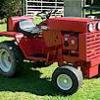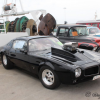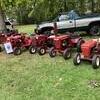
D-200 Automatic restoration project (re posted)
By
wheeledhorseman, in Wheel Horse Tractors
-
Similar Content
-
.thumb.jpg.bc8e484711dfd580d76688cb5d3c5d7d.jpg) By Southern_Secret
By Southern_Secret
Hello fellow Horse Heads long time no post for me, life gets crazy & a lot of things change sometimes but anyhoo. So back a few years ago when I first got my 1994 314-H I had it at my shop going threw it. One of my customers walk past as im working and said, you know I think Iv got a Wheel Horse & im thinking "no you dont buddy". I give him my # to send pics thinking it was a big waste of time & after getting the pics I realized he did have a Wheel Horse! I hand shake bought it right there, asked him to bring it to my store & he said no problem. Well after almost 2 years it is finally in my orbit. I know very little about it other than his father-inlaw got it new and used it around his house moving snow and stuff. His father inlaw moved down south here when his daughter got married and gave the tractor to my customer because he had a farm & his the inlaw had no use for it anymore. Same with every barn find, "it was running when parked" 8 years ago, said one of the axel seal is leaking. Im happy and hope I can get it back in running order soon cause it is going to be handy around the truck farm!!
I will post Pics as soon as I reinstate my membership
-
 By Swemill
By Swemill
Hi everyone!
Long time since i was here and my old pics is gone from the forum.
I just uploaded a movie with pics on youtube, and thought i could share it for you guys.
I would love to get some comments on my Youtube channel, from you true Wheel Horse fans!
Thanks and Best Regards
-
 By 87buickt
By 87buickt
Listing for a friend, late 70s I believe D200 deck and plow. Been sitting for a while, make reasonable offer, friend also has tons of literature he may part with, if Interested let me know
-

-
 By wh315-8
By wh315-8
Anyone be able to measure out the Top Link Bar for the 50” D Series Tiller?
Just finished rebuilding a tiller, have a adjustable type but would like to put a original type on like the manual has listed.
-
